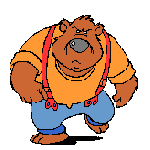

|
|
|
|
Unit of Study Title:
Bears
Topic Area: Science
Grade Level: Kindergarten
Time Frame: one month
Key Words: characteristics, species, habitats, similarities, differences,
Unit Designer:
Randy Weier (rw030)
Unit Designer E-mail: randy.weier@k12.sd.us
School District: Tyndall Elementary
Date : June 21, 2002
Peer Reviewer:
Kurt Stukel (ks036)
Peer Reviewer E-mail: kurt.stukel@k12.sd.us
SD Content Standard
Goals (SD
Content Standards):
Science
Students will explore, evaluate, and communicate personal and scientific
investigations to understand the nature of science while learning about bears.
SD Content Standard
Indicators: Life
Science Standards
SD Content Standard
Benchmarks:
Other Content
Standards:
No other standards.
Brief Summary of Unit:
1. The students will talk about their favorite kinds of bears and why they like
them. They will discuss how bears are alike and different. Then pictures will be
displayed of different bears and the students will compare them.
2. The students will understand that a bear habitat is the place where bears
lives and that a bear lives in a particular habitat because it can find food,
water, and shelter there. They will look at different books to see bears in
their surroundings and compare them with other kinds of bears in other habitats.
3. The students will compare the different kinds of foods the different species
of bears eat in their diets.
4.
The students will discuss reasons why the bears live in the habitats that they
live in and how they have adapted to that area.
Students will Understand:
1. Describe similarities and differences of bears.
2. Compare bears in their immediate surroundings with other animals in their
habitats.
3. Describe how the different species of bears live in their own habitats.
4. Compare the different characteristics of the bears.
Essential Questions to Guide this Unit and Focus Teaching and Learning:
1. How did you decide which bear lives in which habitat? How many ways did you
classify the bear?
2. Where does your bear live? How does your bear meet its needs?
3. How are the characteristics of the different bears alike and different?
4. What are some of the foods that each different kind of bears eats?
Key Knowledge and Skills Students will Acquire:
1. The student will draw and tell similarities and differences of bears.
2. The student will be able to compare bears in their immediate surroundings
with those in other habitats.
3. The student will be explain the different characteristics of the bears.
4. The student will be able to explain what different kinds of foods the
different species of bears eat.
Assessment Plan:
A child earns an S for participation and completion of activities. A child will
receive a U if the child does not finish activities or participate. (Adjustments
are made for IEP students). An end of the unit bear book will be a final project
that each student will make. This
will saved in their portfolio for parent/teacher conferences.
Learning Activites:
1. The students will read and discuss the different books from the unit in
Reading (Here Come the Bears).
2. They will do worksheets and fun sheet about bears together in groups.
3. Children will arrange pictures in groups according to their similarities.
4. The children will watch a power point presentation on bears.
5. The children will read other books about bears some example of books about
bears would be: Two Bear Cubs, A
Day in the Life of A Baby Bear, The Book About Bears, Bear Tracks.
6. The children will use the Internet for research.
7. The children will create a story about a bear with the computer program
Baillies Book House.
8. Information will be sent home so that the parents can try to find
books about bears at their house. They can discuss with their child what they
have learned about bears and how it pertains to the story they read.
9. While using the Internet
the students will hear various bear sounds from the different species of bears.
Notes:
This will be a useful Unit Of Study for Bears. The users will need the Science
textbook, worksheets from the workbook, pictures of bears, a variety of books
about bears, and the Internet.
Internet Resource Link:
http://www.bearbiology.com/brdesc.html
Information about brown bears.
http://www.bearbiology.com/bbdesc.html
Information about black bears.
http://www.makura.com/paul/panda.html
Information about panda bears.
http://www.nps.gov/bela/html/bears.htm
Information about grizzly bears.
http://www.polarbearsalive.org/facts.htm
Information about polar bears.
Peer Reviewer Comments:
This unit can be very useful in teaching the students about different types of
bears and their habitat in a fun and upbeat way.